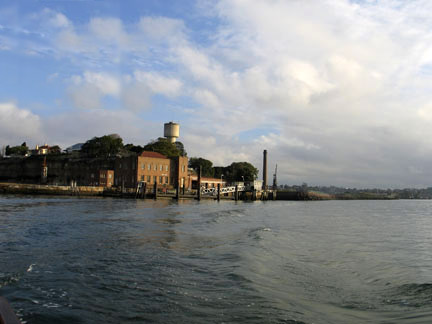
| Search JoyZine with Google Site Search! |
|
Cockatoo Island
In 1839 owing to orders to discontinue transportation from New South Wales to Norfolk Island, and Lieutenant Governor Franklin’s refusal to receive the transportees in Van Diemen’s Land, Governor Gipps formed an establishment on Cockatoo Island for the reception of prisoners removed from Norfolk Island. Gipps saw Cockatoo Island as being secure due to the deep waters surrounding it, and he felt that it was still close enough to Sydney to be under the eye of the authorities. The only form of classification practised on the Island was to separate those recently sentenced in the colony to transportation from those doubly convicted and returned from Norfolk Island, by placing them in separate wards at night. The first Superintendent was Thomas Rawson who was appointed February 1841, but he was replaced by Thomas Ormsby in September of the same year. Cockatoo Island operated as a convict penal establishment from 1839-69, primarily as a place of secondary punishment for convicts who had re-offended in the colonies. In the 1820s convicts provided cheap labour to free settlers and relieved the burden on the British Treasury. For those who committed offences within the colony, or whose crimes were such that they could not be assigned, life was often much harder. In June 1838 an Act was passed substituting hard labour for transportation to a place of secondary punishment. Cockatoo Island was selected by Governor Gipps as the ideal location for a place of hard labour—it was isolated, easy to provision and secure, but not distant and as a result 'under the very eye of authority'. Convicts sent to Cockatoo Island were subject to harsh living and working conditions. The main form of hard labour on the island was quarrying, labouring and construction. Convicts excavated 580,000 cubic feet of rock, creating 45 foot (14 metre) sandstone cliffs to prepare an area to construct a dock. The Fitzroy Dock was constructed between 1839-1847 and is the only remaining dry dock in Australia that had been built using convict and prisoner labour. The lower part of the island, which surrounds the central area, has been mostly levelled and developed for dockyard purposes and still accommodates a range of industrial buildings, concrete pads from demolished buildings, cranes, dry docks and wharf related structures. Fitzroy dock is 145 metres in length and its sides are stepped with quarried sandstone blocks to facilitate the propping of ships for stabilisation. Twelve of the original 15 bollards remain in place. Sutherland dock is also excavated into the island's sandstone and is lined with concrete. It is 212 metres long, 27 metres in breadth and the depth of the water over the sill at high tide is 9.75 metres. Convicts also constructed impressive underground silos to store wheat. These were hand hewn in rock and averaged 19 feet (5.8 metres) deep and 20 feet (6 metres) in diameter. The silos were built in response to the severe drought of 1837-39 and were part of a strategy to reduce the colony's reliance on infrequent grain shipments. At this time a number of complaints about the administration of Cockatoo Island were being made to the Government. As a result, in 1858 a Report from the Board of Inquiry into the management of Cockatoo Island concluded that problems on Cockatoo Island arose from the endeavour to combine the two objectives of making the island a penal establishment, and at the same time of employing the convicts on public works projects. The Report also recommended that Superintendent Ormsby be replaced, as he had demonstrated disregard for regulations, and had made improper use of the convict labour. As a result Gother Kerr Mann, who was the Civil Engineer at Cockatoo Island, was appointed Engineer-in-Chief and Superintendent of Cockatoo Island. By 1865 only those convicts sentenced to the Roads or Public Works were imprisoned on the Island. In July 1869 the Executive Council approved the breaking up of the penal and engineering establishment on Cockatoo Island and the transfer of the prisoners to Darlinghurst Gaol. The administration of the prison and dockyard was divided between two bodies. The land above the escarpment remained in institutional use under the newly appointed NSW Department of Prisons, while the foreshores became dedicated to dockyard use under the Public Works Department. On 21 October 1869 all the prisoners remaining at Cockatoo Island were removed to Darlinghurst Gaol. From 1871 to 1888 the prison barracks became an industrial school for girls and a separate reformatory for girls under 16 convicted of a crime. In 1871 the wooden sailing ship, the NSS Vernon moored at Cockatoo Island for the training of delinquent, homeless or orphaned boys in seamanship. Later the more trustworthy boys were given trade training in some of the dockyard workshops on shipbuilding and repairs. The girls' reformatory was relocated to Watsons Bay in 1879 and the industrial school for girls closed in early 1888. Overcrowding elsewhere in the colony forced the return of prisoners to Cockatoo Island in June 1888. From at least as early as 1870 the island was referred to as ‘Biloela’, an Aboriginal word for ‘black cockatoo’. The dockyard’s official title was ‘Government Dockyard – Biloela’ until its sale to the Commonwealth in 1913. From 1913 the official name of the dockyard was changed to ‘Commonwealth Naval Dockyard, Cockatoo Island’, and the use of ‘Biloela’ was confined to such items as the name of several vessels built at the dockyard (although one was named after the Queensland town, not the Island), and the staff magazine 1976–91, Biloela Bulletin. |
